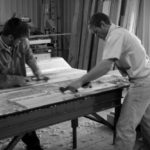A History of Wood Floors
Posted: March 15, 2018Source: The Craftsman’s Blog
History

However, things in the New World were different. The abundance of wood brought common use of wood plank flooring to the masses during the Colonial Era (1607-1780). At last the new Americans could get off the earthen floors and enjoy the resiliency and warmth of wooden floors.
In some ways, flooring has changed a lot since its earliest days and in other ways it has remained much the same. From 1800-1945 wood floors were available in local species of trees and were installed in relatively simple patterns except for the ultra rich. When it came to residential flooring wood was king for these years. Competing only with tile or linoleum in the bathrooms and kitchens. The cost of wall to wall carpeting was still prohibitively high.
After WWII everything changed and hardwood flooring began a three decades decline. Carpeting became cheap with the advent of synthetic fibers and hardwood was deemed “outdated.” It wasn’t until the 1990s that hardwood floors began to rise in prominence again. The introduction of engineered wood floors made wood more affordable, even if it is a less than stellar product. And recently, homeowners have begun to rediscover solid hardwood floors and their many benefits.
Finishes
In the beginning flooring wasn’t finished. It was worn smooth by generations of foot traffic. There were several ways that wood flooring was finished in the old days, and none of them were particularly effective or long lasting. Floors had to stand up to lots of foot traffic bringing in dirt, sand, and water which all served to wear away the flooring.
- Wax – Waxing was a early form of finish to help prevent the evils of water and wear, but it isn’t a hard finish and thus required frequent re-application which was trying.
- Shellac – Shellac is made from the residue of the lac bug of India. Shipped worldwide in lac “flakes”, and mixed with denatured alcohol until the flakes are dissolved and then applied to the wood surface and allowed to dry. While useful on furniture and trim, it was not the best on floors due to its delicate nature and its tendency to darken with wear and moisture. Often floors were shellacked and then had wax applied over top to protect the shellac.
- Varnish – Varnish was an impressive improvement to wood finishes. It was discovered in the mid 18th century but didn’t really gain in popularity until after the Civil War. Compared to its predecessors, varnish is much harder and resists most anything. Tung and linseed oils were the principle varnish oils used as they penetrated the wood to provide for a relatively strong finish. The disadvantages of varnish is that they were slow drying compared to shellac and by todays standards provided a finish that was still fairly soft.
- Polyurethane – Polyurethane was discovered in 1936 and became commercially available around 1940. Though this type of floor finish was not a part of most historic homes because of its late discovery, it by far the most common after-factory finish applied to wood flooring today. The reason? It dries relatively quickly, and most importantly, provides an extremely hard and durable surface that can last a decade or more without any care other than an occasional mopping. Polyurethane essentially creates an impenetrable layer of hard plastic over you wood floor. When applied properly, it is self leveling and very smooth. This is the preferred method of floor finishing we recommend even though not historically accurate because it maintains the wood and protects it against decay and wear more effectively than any of its predecessors.
Why Wood?
We’ll leave you with some parting thoughts if you are considering tiling over or carpeting over your antique wood floors…don’t! Of course, we can’t argue for one person’s decorating taste over another’s, but wood floors are a resilient flooring choice that will last hundreds of years if cared for properly. Even the finest carpet wears out after only a few years of traffic. Tile can chip when something is dropped on it and does’t respond well to the years of expansion and contraction that houses undergo. Vinyl can tear just by looking at it crossly! Wood flooring is long lasting, easily repairable (by a pro), and breathes with your house over the years.
Nothing can compare to the warmth that wood floors add. There are a myriad of different species with different grain patterns and colors and even more choices when you add in the option of stain. The Heart Pine floors in George Washington’s Mt. Vernon estate are still going strong after 250 years. If they were good enough for our founding fathers aren’t they good enough for the rest of us?
